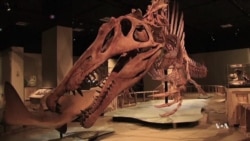Scientists have given us a look at what they believe was the planet's first semi-aquatic dinosaur - or at least their idea of what the creature called Spinosaurus looked like.
The dinosaur spent part of its life living and hunting in the waters that covered northern Africa 95 million years ago - a 15-meter-long, semi-aquatic giant even bigger than Tyrannosaurus rex.
The first Spinosaurus aegyptiacus fossils were found in Egypt more than a century ago. Using newly discovered fossils from the Sahara desert in Morocco, CT scans and digital reconstructions, an international team of researchers was able to create an anatomically precise, life-size, 3-D replica of its skeleton, revealing previously unknown aquatic adaptations.
Spinosaurus had small nostrils in the middle of its skull, which allowed it to breathe when part of its head was under water. Its long neck and short powerful hind legs made it agile in the water, but unlikely to walk upright on land like other predatory dinosaurs. The researchers propose it may have had webbed feet for walking on the soft mud of riverbanks.
Its back was topped with a sail-like structure of bony spines seven feet (two
meters) tall and connected by skin. It stuck out of the water as Spinosaurus waded and swam after prey like sharks, car-size fish and crocodilians.
"The animal is unlike any other predatory dinosaur. There's no blueprint for it. There's no modern-day equivalent for it. It's looking at a completely new kind of animal," said University of Chicago paleontologist Nizar Ibrahim, who led the study published in the journal Science.
Spinosaurus terrorized a vast North African river system from Morocco to Egypt. It may not have been agile on land, Ibrahim said, but occasionally may have taken down other dinosaurs.
"Its snaggle-tooth snout, sickle-shaped claws and monstrous sail give this beast a bizarre profile, one that will be immediately recognized by every kid on our planet," added University of Chicago paleontologist Paul Sereno, who also participated.
Spinosaurus, more than three meters longer than the largest known T. rex, is the second giant dinosaur announced this month. The fossilized remains of the 26-meter-long Dreadnoughtus were found in southern Argentina, and described last week by scientists from Drexel University.
A replica of Spinosaurus is currently on display the National Geographic Museum in Washington D.C. The reconstructed skeleton will eventually head back to Morocco, where it could form the centerpiece of a new museum.
Some information for this report provided by Reuters.









